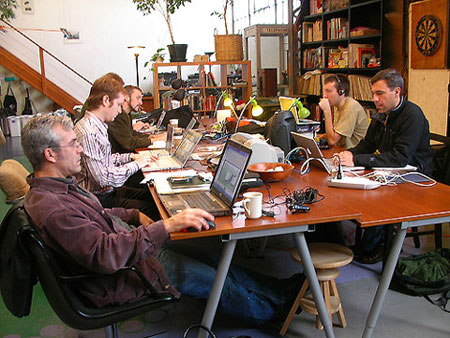I was at a Hertz car rental stop the other day, and as I waited in the customer service line for 20 minutes after spending 10 minutes trying to use their busted self-service machines, I found myself staring at walls and walls covered in ads about how great Hertz was. Apparently, Zagat had rated them best in approximately everything, and they felt the need to spend all of their wall real estate sharing that information with us. I was already frustrated, and their self-aggrandizing house ads just aggravated me more. What benefit was I deriving from knowing how great everybody else thought they were? Why couldn't they use that space to give me some useful information instead?
This reminded me of something else that I see every day that annoys me in the same way: vanity tweets.
What are they?
When I say a "vanity tweet", I mean a tweet or often a retweet that is entirely about how great a particular Twitter user is. Corporate Twitter brands are particularly apt to issue vanity tweets, like this one from @GoogleMapsAPI:

Why do we tweet them?
There are a few main reasons why we make these vanity (re)tweets:
- We want to thank someone for their compliment, and one way of acknowledging their compliment is to share it with the world. Often times they have less followers than us, so it's a boost to their Twitter reputation when we retweet or mention the complimentary user.
- We are happy when someone praises us, and we want everyone to know how happy we are - basically, it's a classic humble brag, that thing that we all find so easy to do on Twitter or any social network, because it re-enforces the ego boost that we got from the original action and makes it last a little longer.
- We want people to look at our stream and think "wow, everybody likes them, so I should like them too!"
Why do I hate them?
As a general rule, vanity tweets provide very little useful information to me as a reader of your stream. Either I already know that you or your product is great and I don't need the reminder, or I don't know it but the vanity tweet does nothing to convince me of it. Or, atleast, I'd argue that it *shouldn't* convince me of it.
What's the alternative?
Here's what I'd suggest instead of vanity tweets:
- Show, don't tell: Instead of tweeting about how great people think you or your product is, tweet about new ways of using it that I didn't know about, like tutorials or blog posts, or tweet about oft overlooked features. Just hearing that something is great won't convince me that it's great, but if I discover some new way of using it that suddenly makes it great for me, then I might be convinced. Here's an example where Trello points out a customer's unique use of their product:

- Instead of acknowledging a compliment by retweeting it, favorite it and personally reply to the complimenter with a sincere thank you. They may not get the follower boost that they'd get out of a retweet, but they will be happy for their praise to be acknowledged. You could maybe even ask them what their favorite feature is, so that you can create a useful tweet out of their praise. Here's an example where Trello responds to a compliment and points them to their recommend tool, too:

- As a general rule for your Twitter stream, be either useful or entertaining to your target audience. If what you are about to tweet is neither of those, then reconsider whether you really want to tweet it. Here's an example of Trello retweeting a useful keyboard shortcut:

Yes, yes...
I don't think that we all need to stop all vanity tweets ever. But I think that we can all safely do less of them, and the Twitter world will be a more useful place. In fact, when I was looking for examples for this post, I was having a harder time finding them than I expected, so perhaps the Twitter world is already a more useful place. Oh, and yes, I'm sure I've been guilty of issuing a few from my own accounts, so this blog post also serves as a reminder to myself.

 A month ago, we launched a new product called "Signature Track." We created it because we wanted to give students a way to verify that they really are who they say they are, and that they are the ones that are actually doing the assessments. That will give their certificates and accomplishments more meaning.
A month ago, we launched a new product called "Signature Track." We created it because we wanted to give students a way to verify that they really are who they say they are, and that they are the ones that are actually doing the assessments. That will give their certificates and accomplishments more meaning.



 I started wearing glasses when I was 8 years old. I'm pretty sure my attraction to big shiny CRT monitors and my tendency to stare directly at the sun contributed to that fact. I hated glasses, because I already felt like a dork, and when I wore them, I felt even dorkier. (See photo for evidence →)
I started wearing glasses when I was 8 years old. I'm pretty sure my attraction to big shiny CRT monitors and my tendency to stare directly at the sun contributed to that fact. I hated glasses, because I already felt like a dork, and when I wore them, I felt even dorkier. (See photo for evidence →)
